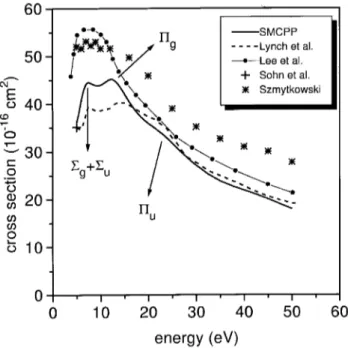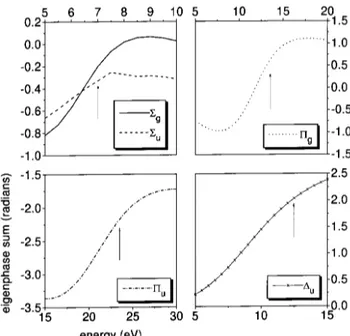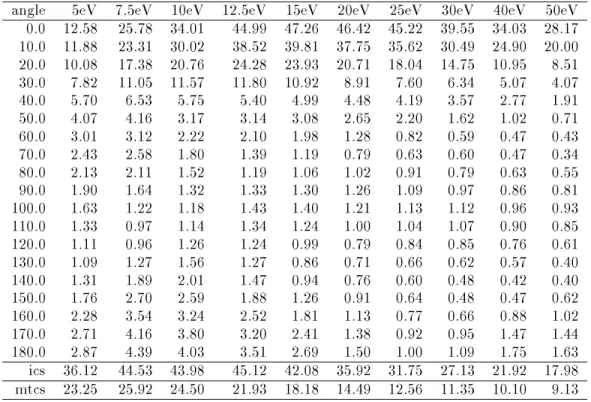Elastic Scattering of Low-Energy Electrons
by Carbon Disulphide
M. H. F. Bettega,
yzA. P. P. Natalense,
xM. A. P. Lima
, and L. G. Ferreira
yDepartamento de Fsica, Universidade Federal do Parana, Caixa Postal 19081, 81531-990, Curitiba, Parana, Brazil
z
Present address: A. A. Noyes Laboratory of Chemical Physics, California Institute of Technology, Pasadena, California, 91125
xPresent address: Department of Chemistry, Texas A & M University,
77843-3255 College Station, Texas
Instituto de Fsica \Gleb Wataghin",
Universidade Estadual de Campinas,
Caixa Postal 6165, 13083-970, Campinas, S~ao Paulo, Brazil Received 4 August, 1999
We report results from anab initiocalculation of low-energy electron scattering by CS2 molecules
using the Schwinger multichannel method with pseudopotentials. We calculated elastic integral, dierential and momentum transfer cross sections in an energy range from 5 eV up to 50 eV and compared our results with available theoretical results and experimental data. Through the symmetry decomposition of our integral cross section and eigenphase sum analysis, we found cross section peaks that may be interpreted as broad shape resonances in the cases of the g, g, u,
and u symmetries. Among these possible resonances, the g, u, and u are being reported for
the rst time.
I Introduction
Studies on electron-collision with CS2have received lit-tle attention in the past years. We can quote the the-oretical work of Lynch et al.[1], the measurements of total cross section by Szmytkowski [2], the measure-ments of elastic cross sections by Sohn et al. [3] and the more recent works by Raj and Tomar [4] and Lee et al.[5]. Lynch et al. used the continuum multiple-scattering model and studied elastic e,-CS
2scattering from 0 eV up to 100 eV. They were able to nd some shape resonances, especially the low-energy u shape-resonance around 1.85 eV. The measurements of Sohn etal. covered the energy range from 0.3 eV up to 5 eV. Szmytkowski measured total cross sections covering the energy range from 0.4 eV up to 80 eV and Raj and Tomar applied the independent atom model to calcu-late cross section for energies above 100 eV. Lee et al. used the Schwinger variational iterative method com-bined with the distorted wave method to study e,-CS
2 scattering. They calculated elastic and total (elastic plus inelastic) cross sections for energies up to 100 eV and also calculated dierential cross sections at selected
energies.
In this work we present results of our calcula-tions on elastic e,-CS
2 collision, obtained with the Schwinger multichannel method with pseudopotentials (SMCPP) [6] at the xed-nuclei static-exchange ap-proximation. We have considered energies ranging from 5 eV up to 50 eV, thus avoiding the very low-energy range, where polarization eects are known to be im-portant in the description of the scattering process. The SMCPP method has been applied with success in the calculation of elastic and inelastic cross sections for electron scattering by several molecular systems [7]. The symmetry decomposition of the integral cross sec-tion according to the irreducible representasec-tions of the molecular point group (D1h) and the eigenphase sums were also investigated in order to study the resonant be-havior of the partial cross sections for some particular symmetries of CS2.
II Theoretical Formulation
Here we will give a brief description of the SMC [8, 9] and SMCPP [6] methods. The SMC method is a mul-tichannel extension of the Schwinger variational princi-ple. Actually, it is a variational approximation for the scattering amplitude, where the scattering wave func-tion is expanded in a basis of (N+1)-particle Slater de-terminants
j ~ki= X
m a
m(~k)jmi; (1)
and the coecients a
m(~k) of this expansion are
varia-tionally determined. The resulting expression for the scattering amplitude in the body frame is
[f~ki;~kf] = ,
1 2
X
m;n
hS~k f
jVjmi(d ,1)
mnhnjVjS~k i
i; (2) where
dmn=hmjA (+)
jni (3)
and
c A(+) = ^H
N + 1,
( ^HP + P ^H)
2 + (V P + PV )2 ,V G (+)
P V: (4)
d In the above equations jS~k
i
i, solution of the unper-turbed Hamiltonian H0, is the product of a target state and a plane wave, V is the interaction potential between the incident electron and the target,jmiis an (N+1)-electron Slater determinant used in the expansion of the trial scattering wave function, ^H = E,H is the total energy of the collision minus the full Hamiltonian of the system, with H = H0+ V . P is a projection operator onto the open-channel space dened in terms of target eigenfunctionsjli:
P =openX
l
jlihlj; (5) and G(+)
P is the free-particle Green's function projected
on the P-space.
In this paper, we study elastic scattering at the static-exchange approximation, and the operator P is composed only by the ground state of the targetj
1 i P =j
1 ih
1
j (6)
and the conguration spacejmiis
fjmig=fAj 1
ij'mig; (7) where j'ii is a 1-particle function represented by one molecular orbital.
With the choice of Cartesian Gaussian functions to represent the molecular and scattering orbitals, all the matrix elements arising in Eq. (2) can be computed an-alytically, except those fromhmjV G
(+)
P Vjni(VGV), that are evaluated by numerical quadrature [9].
The numerical calculation of the matrix elements from VGV represents the most expensive step in the
SMC code and demands almost the entire computa-tional time of the scattering calculation. These matrix elements are reduced to a sum of primitive two-electron integrals involving a plane wave and three Cartesian Gaussian functions
hjVj~ki= Z Z
d~r1d~r2(~r1)(~r1) 1r 12
(~r2)e
i~k:~r2; (8) and must be evaluated for all possible combinations of , and and for several directions and moduli of ~k. We must also evaluate one-electron integrals of the type
hjVPPj~ki= Z
d~r(~r)VPPei~k:~r: (9)
In the above equation, VPP is the nonlocal
pseudopo-tential operator given by:
^VPP(r) = ^Vcore(r) + ^Vion(r); (10)
with
^Vcore(r) =, Zv r " 2 X i=1
ccorei erfh
(corei )1=2 ri
#
; (11) and
^Vion(r) =
1 X n=0 3 X j=1 2 X l=0
Anjlr2ne, j lr
2 +l X
m=,l
jlmihlmj; (12) where Zv is the valence charge of the atom and in this
application it is equal to 4 for C, and 6 for S. The coef-cients ccorei , Anjl, and the decay constants corei and
Even for small molecules composed by light atoms, a large number of the two-electron integrals must be evaluated. This limits the size of molecules in scat-tering calculations. In the SMCPP method we need shorter basis set to describe the target and scattering and consequently the number of two electron integrals is smaller than in the all-electron case. The one-electron integrals of Eq. (9) are more complex than those involv-ing the nuclei, but they can be calculated analytically and their number is also reduced due to the smaller basis set. The reduction in the number of these inte-grals allows the study of molecules that are larger and heavier than those reachable by all-electron techniques.
III Computational Procedures
The ground state of the molecule, 1
g, is described by a single-conguration wave function j
1
i (Hartree-Fock level) at the experimental geometry with r (C-S)=1.5526A [11]. The 1score electrons of carbon and the 1s;2s, and 2pcore electrons of sulfur were replaced by the pseudopotentials of Ref. [10]. The basis func-tions used in the description of the target ground state j
1
iand in the description of the scattering orbitalsj' i
i used in Eq.( 7) are given in Table 1, and were obtained as described in Ref. [12]. We have not included in our calculations the symmetricalcombination ofdfunctions (,
x 2+
y 2+
z 2
exp(,r 2)
), which is in fact as-type function, in order to avoid the linear dependency in the basis set that could be responsible for spurious struc-tures in the cross sections [13].
Table 1. Cartesian Gaussian functions for carbon and sulfur
C S
Type Exponent Exponent s 12.494080 7.382257 s 2.470291 2.063167 s 0.614027 0.878009 s 0.184029 0.245161 s 0.036799 0.061630 s 0.013682 0.015560 p 5.228869 7.203417 p 1.592058 3.134723 p 0.568612 0.529380 p 0.210326 0.154155 p 0.072250 0.035523 d 0.831084 1.689035 d 0.229204 0.476317 d 0.075095 0.151558
aCartesianGaussianfunctionsaredenedby lmn=Nlmn(x,ax)l(y,ay)m(z,az)nexp(,j~r,~aj
2 )
IV Results and Discussion
Fig. 1 shows the comparison between our integral cross section, the calculated cross section of Lynchetal. [1] and Leeetal.[5], and the measured total cross section of Szmytkowski [2]. We also show the data at 5 eV of Sohnet al.[3]. There is very good agreement between our results and the results of Lynch etal. for energies above 15 eV. Both calculations agree with the result of Sohn et al. at 5 eV, and also follow the shape of the total experimental cross section data of Szmytkowski. For energies between 5 eV and 15 eV, the agreement be-tween both these theoretical results is qualitative. The cross section of Leeetal. is above our cross sections and the cross section of Lynch et al. for the entire energy range considered. The structures in our integral cross section are related to structures in the partial cross sec-tions for particular symmetries, as discussed below.
Figure 1. Integral cross section for CS2. Solid line, our
pseudopotential results; dashed line, theoretical results of Ref. [1]; thin solid line with circles, theoretical results of Ref. [5]; plus sign, experimental elastic datum of Ref. [3]; stars, experimental total cross section of Ref. [2]. The ar-rows indicate the structures positions and the symmetries they appear are also shown.
integral cross section due to the signicant background from other symmetries at this energy.
Figure 2. Symmetry decomposition of the integral cross section.
Figure 3. Eigenphase sum for the g, u, g, u and u
symmetries. The arrows indicate the peaks position of the partial cross sections of Fig. 2. The peaks for the g and
u symmetries are located at the same energy.
In order to study possible resonant behavior in our partial cross sections we have also calculated the eigen-phase sum for each one of the symmetries. Our results are shown in Fig. 3 for possible resonant symmetries (those with bumps in Fig. 2). For each symmetry, we
mark with an arrow the energy at the peak and it is always close to the maximum slope of the eigenphase. Therefore, this gure indicates that the structures re-ferred to in the previous paragraph for the symmetries g, g, and u may be, in fact, broad shape reso-nances. In the case of u, the structure located at 12.5 eV, is very broad and cannot be seen in the integral cross section due to its very low magnitude. Lynchetal. also reported the g resonance, placed at 7.9 eV. The g, u, and uresonances are being identied in this work for the rst time. In the case of u, there is a spu-rious and very sharp resonance around 8.0 eV which is resposible for the slope discontinuity of the eigenphase sum in Fig. 3. We are not interpreting that discontinu-ity as a real resonance because the phase change is too small.
Figure 4. Dierential cross sections for CS2. Lines, our
pseudopotential results; thin solid line with circles, theoret-ical results of Ref. [5]; plus signs, experimental elastic data of Ref. [3].
Finally, Fig. 5 shows our momentum transfer cross section. There is no available results for comparison. In Table 2 we present our results for dierential, inte-gral, and momentum transfer cross sections at selected energies.
Figure 5. Momentum transfer cross section.
V Summary
We presented results for elastic scattering of low-energy electrons by CS2molecules. Our results agree very well with the available theoretical and experimental results. Through the symmetry decomposition of the integral cross section and eigenphase sum analysis we tenta-tively assign the cross section peaks to broad shape resonances for the g, g, u, and u symmetries, at 7 eV, 13.5 eV, 23 eV, and 12.5 eV respectively. In this work, we have identied these resonances for the rst time, except for the g one, reported by Lynch
et al.[1] at 7.9 eV.
Acknowledgments
M.H.F.B., L.G.F. and M.A.P.L. acknowledge sup-port from CNPq. A. P. P. N. acknowledges supsup-port from FAPESP. M.H.F.B. also acknowledges partial sup-port from FUNPAR. Our calculations were performed at CENAPAD-SP, at CENAPAD-NE and at CCE-UFPR. The authors acknowledge Mr. Marcio T. do N. Varella for his suggestions concerning this manuscript and Mr. Marlus Koehler for digitizing the results of Lynchetal..
Table 2. Tabulated cross sections for CS2 at selected energies. The cross sections are in 10
,16cm2and the scattering angles are in degrees.
angle 5eV 7.5eV 10eV 12.5eV 15eV 20eV 25eV 30eV 40eV 50eV 0.0 12.58 25.78 34.01 44.99 47.26 46.42 45.22 39.55 34.03 28.17 10.0 11.88 23.31 30.02 38.52 39.81 37.75 35.62 30.49 24.90 20.00 20.0 10.08 17.38 20.76 24.28 23.93 20.71 18.04 14.75 10.95 8.51 30.0 7.82 11.05 11.57 11.80 10.92 8.91 7.60 6.34 5.07 4.07
40.0 5.70 6.53 5.75 5.40 4.99 4.48 4.19 3.57 2.77 1.91
50.0 4.07 4.16 3.17 3.14 3.08 2.65 2.20 1.62 1.02 0.71
60.0 3.01 3.12 2.22 2.10 1.98 1.28 0.82 0.59 0.47 0.43
70.0 2.43 2.58 1.80 1.39 1.19 0.79 0.63 0.60 0.47 0.34
80.0 2.13 2.11 1.52 1.19 1.06 1.02 0.91 0.79 0.63 0.55
90.0 1.90 1.64 1.32 1.33 1.30 1.26 1.09 0.97 0.86 0.81
100.0 1.63 1.22 1.18 1.43 1.40 1.21 1.13 1.12 0.96 0.93
110.0 1.33 0.97 1.14 1.34 1.24 1.00 1.04 1.07 0.90 0.85
120.0 1.11 0.96 1.26 1.24 0.99 0.79 0.84 0.85 0.76 0.61
130.0 1.09 1.27 1.56 1.27 0.86 0.71 0.66 0.62 0.57 0.40
140.0 1.31 1.89 2.01 1.47 0.94 0.76 0.60 0.48 0.42 0.40
150.0 1.76 2.70 2.59 1.88 1.26 0.91 0.64 0.48 0.47 0.62
160.0 2.28 3.54 3.24 2.52 1.81 1.13 0.77 0.66 0.88 1.02
170.0 2.71 4.16 3.80 3.20 2.41 1.38 0.92 0.95 1.47 1.44
180.0 2.87 4.39 4.03 3.51 2.69 1.50 1.00 1.09 1.75 1.63
[1] M. G. Lynch, and D. Dill, J. Chem. Phys. 71, 4249
(1979).
[2] C. Szmytkowski, J. Phys. B: At. Mol. Phys. 20, 6613
(1987).
[3] W. Sohn, K-H. Kochem, K. M. Scheuerlein, K. Jung, and H. Ehrhadt, J. Phys. B: At. Mol. Phys. 20, 3217
(1987).
[4] D. Raj, and S. Tomar, J. Phys. B: At. Mol. Opt. Phys.
30, 1989 (1997).
[5] M. T. Lee, S. E. Michelin, T. Kroin, and E. Veiten-heimer, J. Phys. B: At. Mol. Opt. Phys.32, 3043 (1999).
[6] M. H. F. Bettega , L. G. Ferreira, and M. A. P. Lima, Phys. Rev. A47, 1111 (1993).
[7] M. H. F. Bettega, M. A. P. Lima, and L. G. Ferreira, J. Phys. B: At. Mol. Opt. Phys.31, 2091 (1998); M. H. F.
Bettega, L. G. Ferreira, and M. A. P. Lima, Phys. Rev. A57, 4987 (1998); S. M. S. da Costa, and M. H. F.
Bet-tega, Eur. Phys. J. D 3, 67 (1998); M. H. F. Bettega,
M. T. do N. Varella, L. G. Ferreira, and M. A. P. Lima,
J. Phys. B: At. Mol. Opt. Phys , 4419 (1998); A. P. P. Natalense, L. G. Ferreira, and M. A. P. Lima, Phys. Rev. Lett.81, 3832 (1998); A. P. P. Natalense, M. H.
F. Bettega, L. G. Ferreira, and M. A. P. Lima, Phys. Rev. A 59, 879 (1999); M. T. do N. Varella, M. H. F.
Bettega, A. J. R. da Silva, and M. A. P. Lima, J. Chem. Phys.110, 2452 (1999).
[8] K. Takatsuka, and V. McKoy, Phys. Rev. A 24, 2473
(1981);ibid.30, 1734 (1984).
[9] M. A. P. Lima, L. M. Brescansin, A. J. R. da Silva, C. Winstead, and V. McKoy, Phys. Rev. A41, 327 (1990).
[10] G. Bachelet, D. R. Hamann, and M. Schluter, Phys. Rev. B26, 4199 (1982).
[11] CRC Handbook of Chemistry and Physics,D. R. Lide Editor in Chief, 73r ded.
[12] M. H. F. Bettega, A. P. P. Natalense, M. A. P. Lima, and L. G. Ferreira, Int. J. Quantum Chem. 60, 821
(1996).


